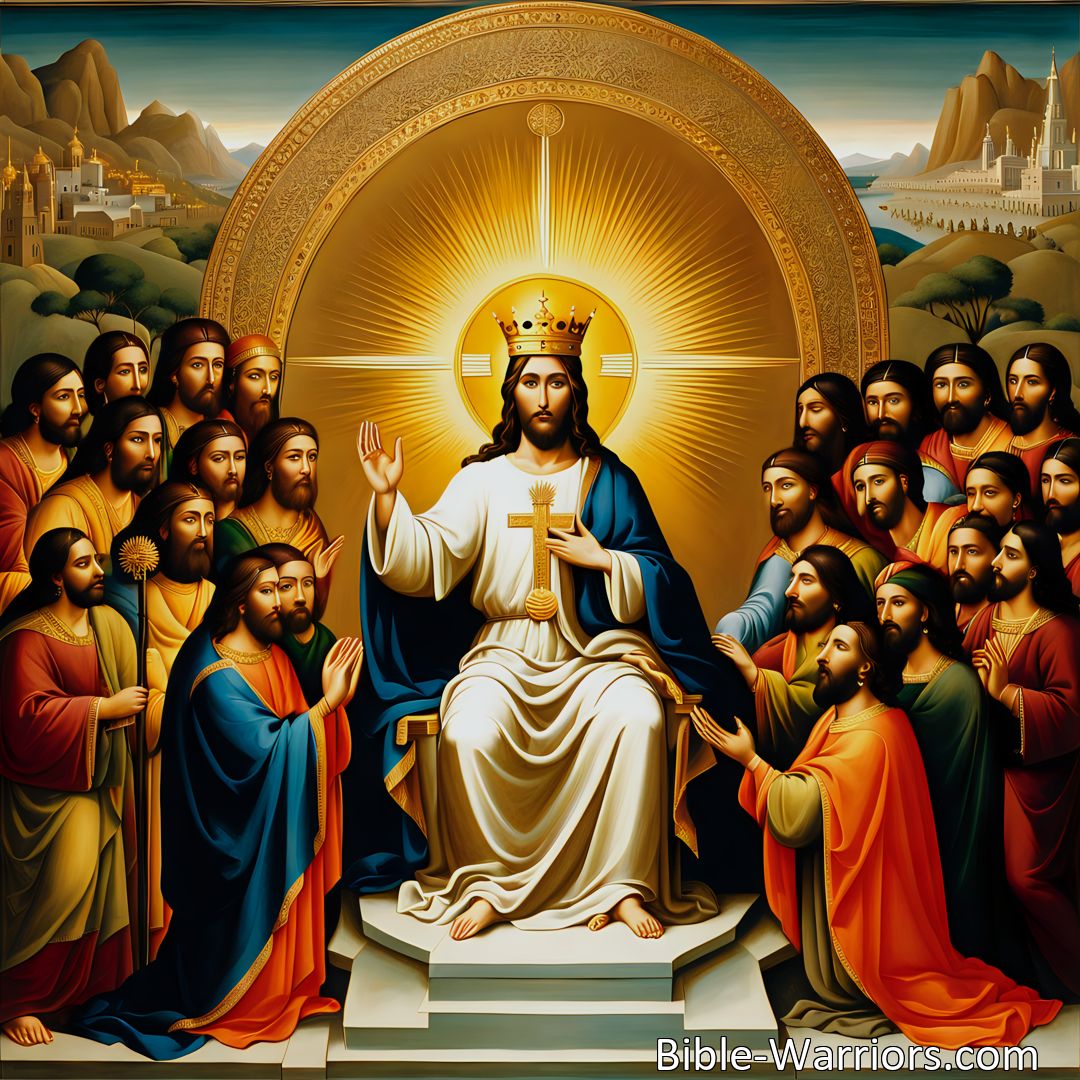Savior, Whom Our Hearts Adore – Hymn Lyric
In the hymn “Savior, Whom Our Hearts Adore,” the writer expresses a longing for Jesus Christ‘s return and His divine rule. The hymn envisions a future where Christ establishes a heavenly realm, redeems the broken world, and brings unity and peace. It speaks to the universal human longing for justice, inclusivity, and harmony, providing comfort and hope to believers.
Table of Contents
Savior, Whom Our Hearts Adore
Savior, Whom our hearts adore,
To bless our earth again,
Now assume Thy royal power,
And o’er the nations reign;
Christ, the world’s Desire and Hope,
Power complete to Thee is given;
Set the last great empire up,
Eternal Lord of Heaven.
Where they all Thy laws have spurned,
Where they Thy Name profane,
Where the ruined world hath mourned
With blood of millions slain,
Open there the ethereal scene,
Claim the heathen tribes for Thine;
There the endless reign begin
With majesty divine.
Universal Savior, Thou
Wilt all Thy creatures bless;
Every knee to Thee shall bow,
And every tongue confess:
None shall in Thy mount destroy;
War shall then be learnt no more:
Saints shall their great King enjoy,
And all mankind adore.
Meaning of Savior, Whom Our Hearts Adore – Hymn Lyric
In this hymn titled “Savior, Whom Our Hearts Adore,” the writer expresses a longing for the return of Jesus Christ and the establishment of His divine rule over the nations. The hymn speaks of Christ as the world’s desire and hope, possessing complete power to set up the last great empire and become the eternal Lord of Heaven.
The hymn acknowledges that there are places on earth where God’s laws have been ignored and His name has been defiled. These areas have experienced great suffering, with countless lives lost. However, the hymn proclaims hope and redemption by envisioning a future where Christ opens up a heavenly realm in these very places and claims the heathen tribes for Himself. It is in these regions that the endless reign of Christ will begin, marked by divine majesty.
The hymn then addresses Christ as the universal Savior who will bless all His creatures. Every knee will bow before Him, and every tongue will confess His lordship. This powerful image suggests a time when all people, regardless of their background or beliefs, will acknowledge Jesus as the one true Savior. In this future world, none will seek to destroy what Christ has established. The hymn prophesies a cessation of wars and violence, as humanity learns the ways of peace.
Furthermore, the hymn declares that in the era of Christ’s eternal reign, saints will rejoice in the presence of their great King, and all mankind will adore Him. This imagery signifies a time of harmony and unity, where believers, referred to as saints, will experience a deep sense of joy in being in the presence of Christ. Moreover, all of humanity will join in adoration, recognizing and praising the greatness of the Savior.
As we delve deeper into the meanings behind each verse, we can understand the hymn’s underlying messages and its significance to believers. While the hymn is written in a religious context, it carries broader themes that resonate with many individuals, regardless of their faith.
One theme evident in the hymn is the longing for a world where justice and righteousness prevail. The recognition that there are places on earth where God’s laws are disregarded and His name is profaned acknowledges the reality of our imperfect world. It highlights the brokenness caused by human sin and the resulting suffering. However, the hymn suggests that there is hope for redemption and restoration. The depiction of Christ’s future reign symbolizes a time when all wrongs will be made right, and the effects of sin will be erased. This theme speaks to the human desire for justice and the longing for a world characterized by peace and harmony.
Another theme present in the hymn is the universal nature of Christ’s salvation. The hymn asserts that every knee will bow before Christ, and every tongue will confess Him as Lord. This notion emphasizes the inclusivity of Jesus’ message and the invitation for all people to partake in His salvation. It speaks to the idea that Christ’s love and grace are not limited to any particular group or ethnicity but are available to all who seek Him. This theme resonates with the human quest for acceptance and belonging, as well as the belief in the inherent worth and value of every individual.
The hymn also envisions a future world where war and destruction cease to exist. By proclaiming that in Christ’s rule, war will be learned no more and saints will enjoy the presence of their great King, the hymn paints a vision of peace and unity. This vision aligns with humanity’s yearning for a world free from violence and conflict, where relationships are characterized by understanding, compassion, and cooperation. It inspires the hope for a better future where people can live in harmony with one another.
In conclusion, the hymn “Savior, Whom Our Hearts Adore” conveys a profound longing for the return of Jesus Christ and His establishment of divine rule over the nations. It speaks of Christ as the world’s desire and hope, possessing complete power to bring about the last great empire. The hymn envisions a future in which God’s laws are honored, healing and redemption are experienced, and unity and peace prevail. Through its themes of justice, inclusivity, and peace, the hymn speaks to the universal human longing for a better world. It offers comfort and hope to those who believe and serves as a reminder of the ultimate fulfillment of these longings that is found in Christ.
I hope this hymn inspired image brings you hope and peace. Share it with someone who needs it today!



